|
What is my Coin Worth?
I get lots of questions about the value of various coins. The best way to
establish the value of your coin is go to your local library and look it up in --
"The Official Red Book. A Guide Book of United States Coins" by R. S.
Yeoman -- or one of several other books on the same subject. To establish
its value you will need to be able to grade it.
The US Mint
has a good description on how coins are graded in their
"Collectors Corner" section or you can see how I grade coins.
Once you have a general idea of the coin's value, you can take it to a local coin dealer and ask
them what it is worth and how they would grade it. You can also visit the
"American Numismatic Association"
(ANA) a nonprofit educational
organization that encourages the study of money throughout the world. This
is the group that established the grading system for coins that is most often used today.
If you are convinced that you have a valuable coin then you can submit the
coin to the
"Numismatic Guaranty Corporation"
(NGC) -- or one of other coin grading services -- and have your coin
graded for a fee. This is by far the
best way to go if you have a valuable coin that you want to sell. The NGC also
has a
Collectors
Society Message Board (Blog)
That you can join for free and ask questions of other dealers and collectors.
What is a Mint Mistake Coin?
These are improperly produced coins that were released into circulation. Most error and misstruck coins are found by the US Mint and recycled before they
are issued. The few that do make it into circulation
are often quite valuable. Mint Mistake Coins are classified into three major categories:
- Planchet Errors -- The planchet is the blank piece of metal a coin is stamped onto.
Sometimes the wrong or a deformed planchet is used. The most
famous case is the 1943 copper penny. It's not uncommon to find a
blank planchet in a roll of coins.
- Striking Errors -- Some times the planchet will be struck off-center or
struck several times producing a "Doubled Die Error" coin.
- Die Errors -- Some times a die will break or a portion of the design
will become filled with metal and not be transferred onto the planchet.
These Mint Mistake Coins are highly prized by some collectors and can be worth a lot of money.
Many known Mint Mistake coins can be found in --
"The Official Red Book. A Guide Book of United States Coins" by R. S.
Yeoman -- or one of several other books on the same subject.
Storing and Cleaning Coin
Coins should be stored in "Archival Safe" holders. There are a
number of methods:
-
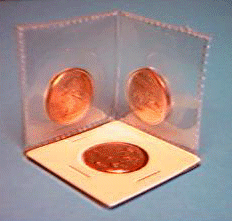 Coin Books or Display Cards are most common. Make sure you
purchase them from a firm that is well know. The paper used to
manufacture the book or card must be acid free or it will discolor the coins over
time.
Coin Books or Display Cards are most common. Make sure you
purchase them from a firm that is well know. The paper used to
manufacture the book or card must be acid free or it will discolor the coins over
time.
- Archival safe Mylar Flips or Mylar and Cardboard holders are great for
permanent storage; however, they must be certified "Archival Safe"
by the manufacture. Not all flips are created equal! The
archival safe ones will be stiff and not soft and flexible. The soft
ones are not archival safe!
- Paper "Bank" rolls are not meant for permanent
storage. The paper contains acid and leaving coins in paper rolls will result in them
discoloring -- turning dark -- over time. If you want to display them or
sell them some time in the future you should remove them from the paper
wrappers and place them in archive safe tubes.
Never clean coins! Inevitably it will damage or discolor
the coins. Most collectors would rather have a coin with a rich patina
then one that has obviously been cleaned or doctored in some way.
The 1909 VDB Cent
In 1909 the Lincoln Wheet Penney was introduced at the request of President Theodore “Teddy” Roosevelt.
The initials VDB were those of Victor David Brenner, who designed the coin.
Because there were strenuous objections
from US Mint insiders to the designer’s initials on the new coin, the initials were removed early in production.
|
There are six versions of the 1909 penny: Four Lincolns from the Philadelphia (no
mintmark) and the San Francisco (S) mints both with and without the VDB
initials. Plus there are two 1909 Indian Head cents from the same two
mints. Note: the "S" mint mark is on the reverse under the wreath of
arrows on the Indian Head cents from the San Francisco mint.
Because of the small number of coins minted, the 1909 VDB is quite rare with the 1909
VDB S being still rarer. The rarest Lincoln penny; however, is the 1943
copper cent.
|
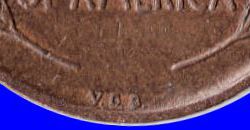
The VDB can be difficult to see without a good magnifying glass.
|
The 1943 Copper Penny
Because of the war, 1943 cents were struck in
steel then plated with zinc to make them look better and keep them from corroding.
They are very rare because only about 40 copper
cents were struck by accident when a few copper planchets (blanks) remained in the hoppers at all
three mints. Depending on condition, a genuine 1943 copper can sell
for $10,000 to $100,000 or more. In 1996 one sold for $82,500. Unfortunately, there are plenty of fake 1943 copper cents floating around. Some
are just steel pennies dipped in or plated with copper. These fakes
will stick to a magnet where a copper coin won't. Other fraud
attempts use a genuine 1948 copper penny and alter the 8, making it
look like a 3 but not like the 3 in the picture.
|
Genuine
1943 Copper Cent
Picture from the US Mint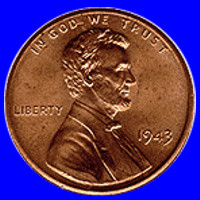
|
What is the Difference between
the 1970 Large and Small Date Pennies?
When you look at the 1970 small date (or high 7) penny, the top of the 7 lines
up with the top of the 9 and the 0. On the Large date (or low 7) the top of the seven
is slightly lower. There are pictures in -- "The Official Red Book.
A Guide Book of United States Coins" by R. S. Yeoman -- at your local library.
As you can see from the pictures below, it is quite difficult to tell the difference.
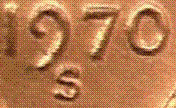 |
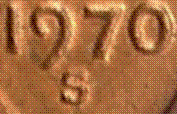 |
| Large date - Low 7 |
Small date - High 7 |
What is a 1979 Type I and Type II Cent?
This refers to the 1979 penny minted in San Francisco. The
Type I has a filled "S" while the rarer and more expensive Type II
has a clear "S". Both types are proof coins and none were released by the
mint for general circulation. In fact, all coins with an "S"
mint mark after 1974 are proof or commutative coins from the San Francisco mint.
What is a 1982 Zinc Penny?
In 1982 the composition of US one cent coin changed. Before 1982 the penny was
composed of 95% copper, 5% zinc and weighed 3.11 grams. After 1982 all pennies
are made from an alloy of 99.2% zinc and 0.8% copper which is then plated with pure copper
giving it a weight of
2.5 grams. Both pennies were produced in 1982; therefore, when you see reference
to a 1982
zinc penny, it is referring to a copper plated zinc penny just like all of the pennies minted today. To
tell the difference between a 1982 copper and zinc penny you must weigh them.
The "Zinc" pennies are 20% lighter than the "Copper" pennies, but they are both
copper in color. To further add to the confusion, there are both large and
small date versions of each. From the Philadelphia mint there are four variations:
copper and zinc, large and small dates. From the Denver mint there are three variations:
copper large date and zinc large and small dates.
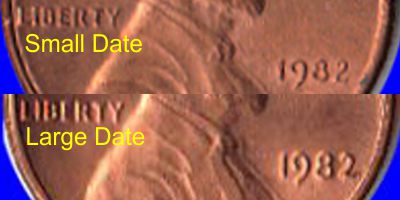
The size of the date is obvious if you compare a large and small date coin side
by side, but individually it is difficult to tell. Look at the 2; it will
be close to the rim on the large date, but noticeable father away on the small
date. There are also pictures in -- "The Official Red Book.
A Guide Book of United States Coins" by R. S. Yeoman -- at your local library.
The only zinc colored penny
minted for circulation was the 1943 zinc plated steel penny. However
some pennies after 1982 have an improperly plated planchet and will be
zinc colored or something between zinc and copper in color. These
are mint mistake cents and are worth a bit more than the copper plated
cents. Other pennies have had their copper plating removed by acid
or have been contaminated by mercury or solder. They are worth
nothing to a collector.
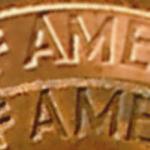
What is a Wide AM Penny?
In 1998, 1999 and 2000 some Lincoln Cent struck for circulation have a noticeable difference in the spacing between
the A and M in AMERICA. On the normal cent the A and M are almost touching. On the Wide AM cents
the A and M show a considerable space between the letters. There is also a difference
in the spacing of the initials beside the Lincoln Memorial. The normal cent is set farther away from
the building than the Wide AM cents.
What are the Four different 2009 Cents?
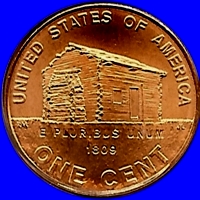
Birth and Early
Childhood in Kentucky
1809-1816
|
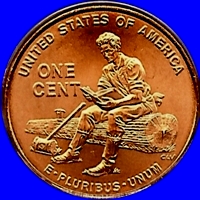
Formative
Years in
Indiana
1816-1830
|
Lincoln Bicentennial Cents
continue to bear the same likeness of President
Lincoln; however, the reverse carries the four designs shown
here. The 2009 cents issued for circulation have the same metal
content (2.5% copper, balance zinc, weight 2.5 grams) as cents after 1982; however, numismatic
versions have the metal content of the 1909 pennies
(95% copper, 5% tin and zinc, weight 3.11 grams). |
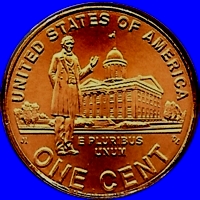
Professional
Life in
Illinois
1830-1861
|
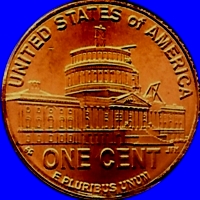
Presidency in Washington, DC
1861-1865
|
|
There are actually 20 variations. The Philadelphia and Denver mints each produced both
the standard and the numismatic versions giving 16 variations while the San Francisco mint
produced numismatic versions of each. The numismatic versions are included in the United
States Mint’s annual product offerings from the P, D & S mints. Both versions from the
P & D mints look the same; the only way to tell them apart is by their weight.
|
Note: To see a close-up picture of any of the 2009
pennies above, just click on it's image.
Blocked?
Click here for information on how to unblock the picture.
What is a Red Cent?
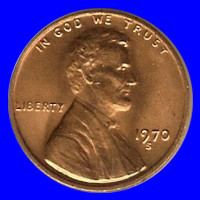 When pennies are minted they have a copper colored Mint Luster and are generally
graded as Mint State (MS-65) or thereabouts depending on number of contact
marks and/or spots. Over time these cents will acquire a patina running from
a reddish-copper to a deep-copper to bronze. Their are collectors
that specialize in these uniquely colored "Red Cent". To
them the overall tone and coloration of the penny is what is
important. They don't necessarily have to be red, but they do have
to have a pleasant tone and coloration, something more than the typical
copper or what they like to call "brown" cent.
When pennies are minted they have a copper colored Mint Luster and are generally
graded as Mint State (MS-65) or thereabouts depending on number of contact
marks and/or spots. Over time these cents will acquire a patina running from
a reddish-copper to a deep-copper to bronze. Their are collectors
that specialize in these uniquely colored "Red Cent". To
them the overall tone and coloration of the penny is what is
important. They don't necessarily have to be red, but they do have
to have a pleasant tone and coloration, something more than the typical
copper or what they like to call "brown" cent.
There are different ways to preserve "Mint State" copper coins or "Red Cents" so
they do not change their color and turn darker. In general one must seal them from the oxygen
in the air so they do not oxidize and acquire a patina. In general a coin
that retains its Mint Luster or has an overall pleasing appearance is worth more then a coin without it.
Altered Coins
One of the more common alteration is a double headed or a double tailed coin.
All that I know of are created by grinding down two coins and joining them. Some
times it is very hard to see where they are joined. Often they are a bit thicker
or don't weigh the same as an unaltered coin.
It is also not uncommon to find coins that have been stamped with the outline of a commercial
product, a state, someone's initials or anything else that will fit. These coins are no longer
of any value to a coin collector. What you have is a novelty item that
may be of interest to some people if you can establish where, when and why the coin was
altered. Look on the Internet to see if you can find one like it or check
with an antiques collector for more information.
Altered or Not?
Below is a very unusual wheat
cent. The obverse (head) has no date and the tail has no
"CENT"! Is it altered? The date
area has been scratched but it looks like somebody was trying to find the date
not remove it. The same is true for the reverse; the "CENT" is
missing and it does not look like it was ever there. There are some
scratches, but not enough to obliterate the letters. Maybe it was some
sort of test striking. I remember reading that the designer Victor David
Brenner, gave some of the prototype coins away to friends. Could this be one of
them?
The consensus from other dealers and collectors on the
Collectors
Society Blog sponsored by the Numismatic Guaranty Corporation
(NGC) is that "It was probably modified post-production" for some unknown reason.
Furthermore, there are no known prototype coins given to friends by Brenner.
|
|
Let me know if you Like this site & please
leave a
comment too let your friends know about it.
|
|
|
For more Information on Coins,
visit the following web sites:
|
Lincoln Cents
for Sale or Trade
|
|
Visit The Penny Trader Web Site.
It has a large selection of Lincoln Wheat, Memorial and Bicentennial Cents from the Philadelphia (no mint mark),
Denver (D) and San Francisco (S) mints from 1909 to the current date.
|
|
50 State Quarters for Sale or Trade
|
|
Visit the 50 State Quarters web site
to buy or trade quarters. These brilliant uncirculated 50 State Quarters
are purchased directly from the Philadelphia (P) and Denver (D) Mints. Bright and shiny Circulated quarters are also available
for sale or trade.
|
|
How Coins are Graded
|
|
Find out how to grade your coins! Visit the
Grading Coins site.
It will explain the most commonly user Coin Grading System.
|
All of the coins are carefully packaged and
sent to you via First Class Mail.
|